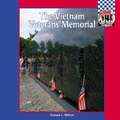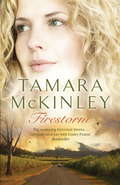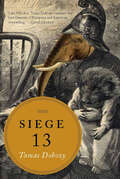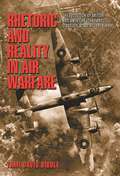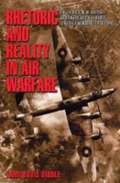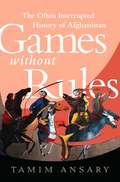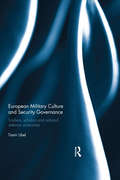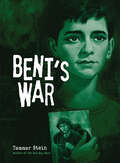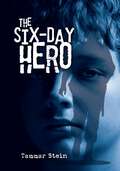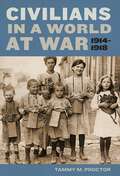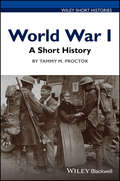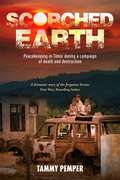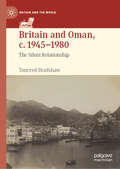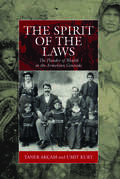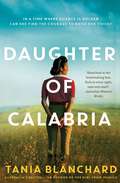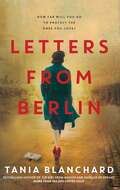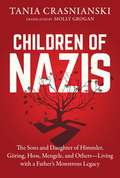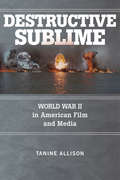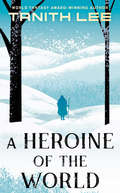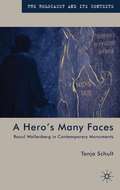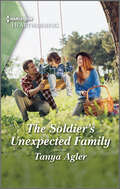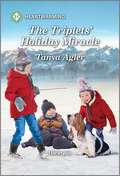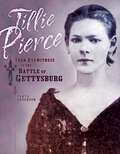- Table View
- List View
The Vietnam Veterans Memorial
by Tamara L. BrittonProvides background information on the Vietnam War and on the memorial that was built to honor those who died during this conflict.
Firestorm
by Tamara McKinleyIf you love Lesley Pearse, you're sure to fall for Tamara McKinley. A tale of hardship, hidden identities and our shared struggle to survive. Becky Jackson's family has been managing the hospital in far-flung Morgan's Reach for three generations. When Becky's husband is tragically lost at war, she and her young son Danny must leave the city and return to her birthplace to start over. But for all its charm, Morgan's Reach is a divided community, where blood is thicker than water and grudges run deep. So when a mysterious stranger appears outside the town and Danny begins to act strangely, it is not only Becky's newfound stability that's threatened. And what of the fact that there's not been a drop of rain in over three years? The risk of wildfire looms large and the hospital is already pushed to breaking point. A single spark could level the area in minutes - burning away everything for which the town has worked so hard; exposing the secrets they've fought to keep so close.
Firestorm
by Tamara MckinleyIf you love Lesley Pearse, you're sure to fall for Tamara McKinley. A tale of hardship, hidden identities and our shared struggle to survive. Becky Jackson's family has been managing the hospital in far-flung Morgan's Reach for three generations. When Becky's husband is tragically lost at war, she and her young son Danny must leave the city and return to her birthplace to start over. But for all its charm, Morgan's Reach is a divided community, where blood is thicker than water and grudges run deep. So when a mysterious stranger appears outside the town and Danny begins to act strangely, it is not only Becky's newfound stability that's threatened. And what of the fact that there's not been a drop of rain in over three years? The risk of wildfire looms large and the hospital is already pushed to breaking point. A single spark could level the area in minutes - burning away everything for which the town has worked so hard; exposing the secrets they've fought to keep so close.
Siege 13: Stories
by Tamas DobozyStories exploring a world of ordinary people caught between the pincers of aggressors, leading to actions at once deplorable, perplexing, and heroic.In the fall of 1944, the Red Army encircled Budapest, surrounding tens of thousands of German and Hungarian troops, and nearly a million civilians. The ensuing months witnessed one of the most brutal sieges of World War II, with block-to-block guerilla warfare followed by widespread disease, starvation, and unspeakable atrocities. Richly grounded in this historical trauma and its extended aftermath, the stories in Siege 13 alternate between the siege itself and a contemporary community of Hungarian émigrés who find refuge in the West.Illuminating the horror and absurdity of war with wit and subtlety, Tamas Dobozy explores a world in which right and wrong are not easily distinguished, and a gruesome past manifests itself in perplexing, often comical ways.Winner of the Rogers Writers’ Trust Fiction PrizePraise for Siege 13“Alice Munro . . . Isaac Babel . . . Those comparisons may sound daunting, but Dobozy has mastered the technical conventions of his craft . . . This vivid rendering of Hungarian history as a nightmare from which no one quite wants to awake is Dobozy’s finest achievement.” —Garth Risk Hallberg, The New York Times Book Review“The sheer variety of Dobozy’s approaches to telling stories, and his commitment not only to provoke thought but to entertain, constitute a virtuoso performance. Siege 13 is without question one of my favorite story collections ever.” —Jeff VanderMeer, The Washington Post“A superb collection of short stories that revisits two of the deadliest months in Hungarian history. The book tells the stories of those who hid, those who fought, those who betrayed, those who escaped and those who died, and how the effects of the siege still linger, three-quarters of a century later. . . . Siege 13 is one of the best books of the year.” —Mark Medley, National Post (Canada)
Rhetoric and Reality in Air Warfare: The Evolution of British and American Ideas about Strategic Bombing, 1914-1945 (Princeton Studies in International History and Politics #98)
by Tami BiddleA major revision of our understanding of long-range bombing, this book examines how Anglo-American ideas about "strategic" bombing were formed and implemented. It argues that ideas about bombing civilian targets rested on--and gained validity from--widespread but substantially erroneous assumptions about the nature of modern industrial societies and their vulnerability to aerial bombardment. These assumptions were derived from the social and political context of the day and were maintained largely through cognitive error and bias. Tami Davis Biddle explains how air theorists, and those influenced by them, came to believe that strategic bombing would be an especially effective coercive tool and how they responded when their assumptions were challenged. Biddle analyzes how a particular interpretation of the World War I experience, together with airmen's organizational interests, shaped interwar debates about strategic bombing and preserved conceptions of its potentially revolutionary character. This flawed interpretation as well as a failure to anticipate implementation problems were revealed as World War II commenced. By then, the British and Americans had invested heavily in strategic bombing. They saw little choice but to try to solve the problems in real time and make long-range bombing as effective as possible. Combining narrative with analysis, this book presents the first-ever comparative history of British and American strategic bombing from its origins through 1945. In examining the ideas and rhetoric on which strategic bombing depended, it offers critical insights into the validity and robustness of those ideas--not only as they applied to World War II but as they apply to contemporary warfare.
Rhetoric and Reality in Air Warfare: The Evolution of British and American Ideas about Strategic Bombing, 1914-1945
by Tami Davis BiddleA major revision of our understanding of long-range bombing, this book examines how Anglo-American ideas about "strategic" bombing were formed and implemented. It argues that ideas about bombing civilian targets rested on--and gained validity from--widespread but substantially erroneous assumptions about the nature of modern industrial societies and their vulnerability to aerial bombardment. These assumptions were derived from the social and political context of the day and were maintained largely through cognitive error and bias. Tami Davis Biddle explains how air theorists, and those influenced by them, came to believe that strategic bombing would be an especially effective coercive tool and how they responded when their assumptions were challenged. Biddle analyzes how a particular interpretation of the World War I experience, together with airmen's organizational interests, shaped interwar debates about strategic bombing and preserved conceptions of its potentially revolutionary character. This flawed interpretation as well as a failure to anticipate implementation problems were revealed as World War II commenced. By then, the British and Americans had invested heavily in strategic bombing. They saw little choice but to try to solve the problems in real time and make long-range bombing as effective as possible. Combining narrative with analysis, this book presents the first-ever comparative history of British and American strategic bombing from its origins through 1945. In examining the ideas and rhetoric on which strategic bombing depended, it offers critical insights into the validity and robustness of those ideas--not only as they applied to World War II but as they apply to contemporary warfare.
Games without Rules: The Often-Interrupted History of Afghanistan
by Tamim AnsaryToday, most Westerners still see the war in Afghanistan as a contest between democracy and Islamist fanaticism. That war is real; but it sits atop an older struggle, between Kabul and the countryside, between order and chaos, between a modernist impulse to join the world and the pull of an older Afghanistan: a tribal universe of village republics permeated by Islam.<P><P> Now, Tamim Ansary draws on his Afghan background, Muslim roots, and Western and Afghan sources to explain history from the inside out, and to illuminate the long, internal struggle that the outside world has never fully understood. It is the story of a nation struggling to take form, a nation undermined by its own demons while, every 40 to 60 years, a great power crashes in and disrupts whatever progress has been made. Told in conversational, storytelling style, and focusing on key events and personalities, Games without Rules provides revelatory insight into a country at the center of political debate.
European Military Culture and Security Governance: Soldiers, Scholars and National Defence Universities (Cass Military Studies)
by Tamir LibelThis book offers the first systematic, comparative analysis of military education and training in Europe within the context of the post-Cold War security environment. Based on an analysis of military education institutions in the UK, Germany, Finland, Romania and the Baltic States, this book demonstrates that the convergence of European military cultures since the end of the Cold War is linked to changes in military education. The process of convergence originates, at least in part, from the full or partial adoption of a new concept by post-commissioning professional military education institutions: the National Defence University. Officers are now educated alongside civilians and public servants, wherein they enjoy a socialization experience that is markedly different from that of previous generations of European officers, and is increasingly similar across national borders. In addition, this book argues that with the control over the curricula and graduation criteria increasingly set by civilian higher education authorities, the European armed forces, while continuing to exist, and hold significant (although declining) capabilities, stand to lose their status as a profession in the traditional sense. This book will be of much interest to students of military, European security policy, European politics, and IR in general.
Beni's War
by Tammar SteinIt's Yom Kippur Eve in 1973, and twelve-year-old Beni thinks his biggest problem is settling in at his new school in the Golan, where his family moved at the end of the Six-Day War. But on Yom Kippur, shocking news comes over the radio: a stunning strike on Israel has begun, led by a coalition of Arab states. In the blink of an eye, Beni's older brother Motti is off to war, leaving Beni behind with his mother and father. As bombs drop around Beni and his family, they flee to safety, every day hoping for news of Motti and the developments of the war. Beni must find a way to aid the war effort in his own way, proving that he too can be a hero, even as he learns along the way that there is dignity in every person, including the people he considers the enemy.
The Six-Day Hero
by Tammar SteinMotti knows that war is coming. Israel is only nineteen years old—the same age as Motti's brave older brother, Gideon—and the tiny country is surrounded by enemies. It's only a matter of time before Egypt, Jordan and Syria attack. Motti wishes he could join the Israeli army like Gideon and be a hero. But when his best friend's family flees the country and his brother goes off to fight, Motti realizes this war isn't a game. His family is in danger, and Israel's very survival is at stake. But hope comes to Motti in unexpected forms. In the kind Ethiopian priest who lives nearby. In his grouchy neighbor, old Mrs. Friedburg. In the young Germans who come to offer help. In his father's childhood friend, a Jordanian man who harbors none of the hate Motti expects. Even in a scrappy stray cat that roams the bombed city without fear. Motti knows his older brother is a hero—but through the six days of the war that will decide Israel's fate, he discovers other heroes in surprising places. He may even be a hero himself.
Civilians in a World at War, 1914-1918
by Tammy M. ProctorWorld War I heralded a new global era of warfare, consolidating and expanding changes that had been building throughout the previous century, while also instituting new notions of war. The 1914-18 conflict witnessed the first aerial bombing of civilian populations, the first widespread concentration camps for the internment of enemy alien civilians, and an unprecedented use of civilian labor and resources for the war effort. Humanitarian relief programs for civilians became a common feature of modern society, while food became as significant as weaponry in the fight to win.Tammy M. Proctor argues that it was World War I—the first modern, global war—that witnessed the invention of both the modern “civilian” and the “home front,” where a totalizing war strategy pitted industrial nations and their citizenries against each other. Civilians in a World at War, 1914-1918, explores the different ways civilians work and function in a war situation, and broadens our understanding of the civilian to encompass munitions workers, nurses, laundresses, refugees, aid workers, and children who lived and worked in occupied zones, on home and battle fronts, and in the spaces in between. Comprehensive and global in scope, spanning the Eastern, Western, Italian, East African, and Mediterranean fronts, Proctor examines in lucid and evocative detail the role of experts in the war, the use of forced labor, and the experiences of children in the combatant countries.As in many wars, civilians on both sides of WWI were affected, and vast displacements of the populations shaped the contemporary world in countless ways, redrawing boundaries and creating or reviving lines of ethnic conflict. Exploring primary source materials and secondary studies of combatant and neutral nations, while synthesizing French, German, Dutch, and English language sources, Proctor transcends the artificial boundaries of national histories and the exclusive focus on soldiers. Instead she tells the fascinating and long-buried story of the civilian in the Great War, allowing voices from the period to speak for themselves.
World War I: A Short History
by Tammy M. ProctorA lively, engaging history of The Great War written for a new generation of readers In recent years, scholarship on World War I has turned from a fairly narrow focus on military tactics, weaponry, and diplomacy to incorporate considerations of empire, globalism, and social and cultural history. This concise history of the first modern, global war helps to further broaden the focus typically provided in World War I surveys by challenging popular myths and stereotypes to provide a new, engaging account of The Great War. The conventional World War I narrative that has evolved over the past century is that of an inevitable but useless war, where men were needlessly slaughtered due to poor decisions by hidebound officers. This characterization developed out of a narrow focus on the Western Front promulgated mainly by British historians. In this book, Professor Proctor provides a broader, more multifaceted historical narrative including perspectives from other fronts and spheres of interest and a wider range of participants. She also draws on recent scholarship to consider the gendered aspect of war and the ways in which social class, religion, and cultural factors shaped experiences and memories of the war. Structured chronologically to help convey a sense of how the conflict evolved Each chapter considers a key interpretive question, encouraging readers to examine the extent to which the war was total, modern, and global Challenges outdated stereotypes created through a focus on the Western Front Considers the war in light of recent scholarship on empire, global history, gender, and culture Explores ways in which the war and the terms of peace shaped the course of the 20th century World War I: A Short History is sure to become required reading in undergraduate survey courses on WWI, as well as courses in military history, the 20th century world, or the era of the World Wars.
Scorched Earth: Peacekeeping in Timor during a campaign of death and destruction
by Tammy PemperAs a UN peacekeeper, I joined the East Timorese fight for life. By then, the earth had drunk the blood of one third of their population. But worse was still to come. I would see it for myself. I saw bodies carried to their deaths, machetes carve flesh from bone, and bullets spray into crowds of Timorese and at us peacekeepers. I learned the true meaning of fear, hopelessness, and courage. Shades of truth were twisted for evil gain. Every day I prepared to die. Decisions I made, which seemed so right, jeopardized the lives of others. Police held automatic weapons to my head, militia wrote my name on death lists, and people drew their last breath, all of them brave, braver than me. For this is the true story of my experience. In the midst of the East Timorese fight for independence, militia were determined to enact their scorched earth policy and raze Timor to the ground. Timorese voted; Timor burned. It is their story, our story: a story that must be told.
Britain and Oman, c. 1945–1980: The Silent Relationship (Britain and the World)
by Tancred BradshawThis book examines the relationship between Britain and Oman since the end of the Second World War up until the Iranian revolution. Particular focus is given to the political and economic development of the state, together with Britain’s various overt and covert interventions, principally in the three decades between 1945 and 1975. The author addresses themes which have previously been unexplored in the literature on Oman and British Imperialism in the Arabian Peninsula, such as the establishment of the Sultan’s Armed Forces, and the impact of the oil industry. The book shows that Sultan Said bin Taymur (r. 1932-1970) enjoyed considerable ‘agency’ in his relations with the British who found it very difficult to persuade him to implement economic development and establish relations with his neighbours. Britain’s relations with successive sultans were deliberately concealed, including the contribution of special forces in fighting Oman’s insurgencies. It is widely argued that when Qaboos bin Said became Sultan in 1970, a ‘renaissance’ occurred, however many newly discovered documents have called this into question. They reveal how an inexperienced Sultan came to power with covert British support, and Whitehall’s direction of the war in Dhofar from afar. These documents highlight the extent of British intelligence cooperation and psychological warfare planning to counter the insurgents in Dhofar. However, as this book demonstrates, the Sultan also relied on non-British advisors, known as the ‘mafia’, to secure financial assistance and establish diplomatic ties across the Middle East. Finally, the book details how British defence assistance continued well beyond the retreat from empire in the Persian Gulf.
The Spirit of the Laws: The Plunder of Wealth in the Armenian Genocide
by Taner Akçam Umit KurtPertinent to contemporary demands for reparations from Turkey is the relationship between law and property in connection with the Armenian Genocide. This book examines the confiscation of Armenian properties during the genocide and subsequent attempts to retain seized Armenian wealth. Through the close analysis of laws and treaties, it reveals that decrees issued during the genocide constitute central pillars of the Turkish system of property rights, retaining their legal validity, and although Turkey has acceded through international agreements to return Armenian properties, it continues to refuse to do so. The book demonstrates that genocides do not depend on the abolition of the legal system and elimination of rights, but that, on the contrary, the perpetrators of genocide manipulate the legal system to facilitate their plans.
Echoes of War
by Tania BlanchardSet in Mussolini&’s Italy amid great upheaval, this is the story of one woman&’s determination to find her place in a world that men are threatening to tear apart. Another heart-rending novel inspired by a true story from Australia's bestselling author of The Girl from Munich. Calabria, Italy, 1936 In a remote farming village nestled in the mountains that descend into the sparkling Ionian Sea, young and spirited Giulia Tallariti longs for something more. While she loves her home and her lively family, she would much rather follow in her nonna&’s footsteps and pursue her dream of becoming a healer. But as Mussolini&’s focus shifts to the war in Europe, civil unrest looms. Whispers of war are at every corner and her beloved village, once safe from the fascist agenda of the North, is now in very real danger. Caught between her desire to forge her own path and her duty to her family, Giulia must draw on the passion in her heart and the strength of her conviction. Can she find a way to fulfill her dreams or will the echoes of war drown out her voice? PRAISE FOR TANIA BLANCHARD &‘Captures the intensity of a brutal and unforgiving war, successfully weaving love, loss, desperation and, finally, hope into a gripping journey of self-discovery.&’ Courier Mail &‘An epic tale, grand in scope … Packs an emotional punch that will reverberate far and wide.&’ Weekly Times &‘A tumultuous journey from order to bedlam, and from naive acceptance of the status quo to the gradual getting of political wisdom.&’ Sunday Age &‘An original and innovative take on the World War II genre that captures the hauntingly desperate essence of the war. Tania Blanchard has written yet another spectacular novel. Don&’t miss this.&’ Better Reading
Letters from Berlin: The Girl From Munich, Suitcase Of Dreams, Letters From Berlin
by Tania BlanchardFrom the bestselling author of The Girl from Munich and Suitcase of Dreams comes an unforgettable tale of love, courage and betrayal inspired by a true story Berlin, 1943 As the Allied forces edge closer, the Third Reich tightens its grip on its people. For eighteen-year-old Susanna Göttmann, this means her beloved adopted family including the man she loves, Leo, are at risk. His mother – Susie&’s godmother – is forced to register as a Jew and wear the Star of David, bearing the resentment of the village she has always called home. Desperate to protect them any way she can, Susie accepts the help of an influential Nazi officer. It means she must abandon any hope of a future with Leo and enter the terrifying world of the Nazi elite. But all is not lost as her newfound position offers more than she could have hoped for … With critical intelligence at her fingertips, Susie seizes a dangerous opportunity to help the resistance. The decisions she makes could change the course of the war, but what will they mean for her family and her future?Praise for Tania Blanchard &‘Packs an emotional punch that will reverberate far and wide&’ Weekly Times &‘Captures the intensity of a brutal and unforgiving war, successfully weaving love, loss, desperation and, finally, hope into a gripping journey of self-discovery&’ Courier Mail &‘A tumultuous journey from order to bedlam, and from naive acceptance of the status quo to the gradual getting of political wisdom&’ Sunday Age &‘Combining historical tragedy, romance, and true stories … Superb and enriching&’ Better Reading
Children of Nazis: The Sons and Daughters of Himmler, Göring, Höss, Mengele, and Others— Living with a Father's Monstrous Legacy
by Tania CrasnianskiIn 1940, the German sons and daughters of great Nazi dignitaries Himmler, Göring, Hess, Frank, Bormann, Speer, and Mengele were children of privilege at four, five, or ten years old, surrounded by affectionate, all-powerful parents. Although innocent and unaware of what was happening at the time, they eventually discovered the extent of their father’s occupations: These men—their fathers who were capable of loving their children and receiving love in return—were leaders of the Third Reich, and would later be convicted as monstrous war criminals. For these children, the German defeat was an earth-shattering source of family rupture, the end of opulence, and the jarring discovery of Hitler’s atrocities. How did the offspring of these leaders deal with the aftermath of the war and the skeletons that would haunt them forever? Some chose to disown their past. Others did not. Some condemned their fathers; others worshipped them unconditionally to the end. In this enlightening book, Tania Crasnianski examines the responsibility of eight descendants of Nazi notables, caught somewhere between stigmatization, worship, and amnesia. By tracing the unique experiences of these children, she probes at the relationship between them and their fathers and examines the idea of how responsibility for the fault is continually borne by the descendants.
Destructive Sublime: World War II in American Film and Media (War Culture)
by Tanine AllisonThe American popular imagination has long portrayed World War II as the “good war,” fought by the “greatest generation” for the sake of freedom and democracy. Yet, combat films and other war media complicate this conventional view by indulging in explosive displays of spectacular violence. Combat sequences, Tanine Allison argues, construct a counter-narrative of World War II by reminding viewers of the war’s harsh brutality.Destructive Sublime traces a new aesthetic history of the World War II combat genre by looking back at it through the lens of contemporary video games like Call of Duty. Allison locates some of video games’ glorification of violence, disruptive audiovisual style, and bodily sensation in even the most canonical and seemingly conservative films of the genre. In a series of case studies spanning more than seventy years—from wartime documentaries like The Battle of San Pietro to fictional reenactments like The Longest Day and Saving Private Ryan to combat video games like Medal of Honor—this book reveals how the genre’s aesthetic forms reflect (and influence) how American culture conceives of war, nation, and representation itself.
A Heroine of the World
by Tanith LeeFor the first time in e-book format, a harrowing tale of war and survival from a master of dark fantasy.Aradia is only thirteen when the war begins. The brutal Saz-Kronians have invaded from the North, laying siege to her homeland, and as the war grows ever closer, Aradia&’s father and mother are called to Fort Hightower to help defend the City. To keep Aradia safe, they send her to live with her Aunt Elaieva, a cold and distant woman, until the danger has passed. But Hightower falls. Her parents die in the battle. And deeply depressed, her Aunt commits suicide—leaving her home and fortune to Aradia. Unfortunately, inheritance laws mean little in the wake of war. The City has surrendered, and Aradia&’s home is taken over by Flag Colonel Keer Gurz, an officer of the occupying Saz-Kronian army, who quickly becomes enamored with her. Yet the war is hardly over. Aradia&’s homeland joins into the Charvro Alliance, gaining new allies and resources, and Aradia finds herself swept up in the Kronian retreat. In order to survive, Aradia must learn to play both sides of the war, taking on many different roles and identities, but never forgetting her love for Thenser Zavion, a soldier some name traitor and others liberator. Even as circumstances make her a pawn in greater power games, Aradia is destined to be at the center of the shifting tides—destined to be a heroine of the world.
A Hero’s Many Faces
by Tanja SchultRaoul Wallenberg is remembered for his humanitarian activity on behalf of the Hungarian Jews at the end of World War II, and as the Swedish diplomat who disappeared into the Soviet Gulag in 1945. This book examines how thirty-one Wallenberg monuments, in twelve countries on five continents commemorate the man.
Tank Spotter's Guide
by Tank MuseumInvented during World War I to break the grim deadlock of the Western Front trenches, tanks have gone on to revolutionise warfare. From the lightning Blitzkrieg assaults of World War II to the great battles in the Middle Eastern desert and the largest ever tank battles on the Eastern Front, tanks have become one of the key components of the 'combined arms' philosophy of warfare. This pocket guide gives the reader all of the essential information on 40 of history's premiere tanks, including the Tiger, Sherman, Panther and M1A1 Abrams. Each tank is presented with a detailed drawing to aid recognition.
The Soldier's Unexpected Family: A Clean Romance (Veterans' Road Ser. #3)
by Tanya AglerHe had a plan…She changed it all!Major Aidan Murphy arrives in the charming small town of Hollydale to take full guardianship of his six-year-old nephew. Only there&’s a slight problem—his vivacious, fiery co-guardian. School teacher Natalie Harrison has no intention of letting Aidan take her best friend&’s heartbroken little boy away. Now Aidan must convince Natalie that blood is stronger than love…even if his heart tells him otherwise.From Harlequin Heartwarming: Wholesome stories of love, compassion and belonging.
The Triplets' Holiday Miracle: A Clean and Uplifting Romance (A Violet Ridge Novel)
by Tanya AglerHome only for the holidays…Or here to stay? Widow Daisy Stanley desperately wants her adorable—if exuberant—triplets to be part of Violet Ridge&’s annual Christmas play. She just wasn&’t expecting this much chaos—and from the looks of it, former air force officer Ben Irwin wasn&’t, either! But when the play&’s director is forced to bow out, Ben and Daisy find themselves volunteering to rescue the production. Now there&’s no avoiding each other, and between frosted cookies, snowball fights and plenty of holiday merriment, her kiddos are quickly stealing his heart. The only problem is that he&’s winning hers, too…A Violet Ridge NovelFrom Harlequin Heartwarming: Wholesome stories of love, compassion and belonging.A Violet Ridge NovelBook 1: The Triplets' Holiday MiracleBook 2: Saving the Rancher
Tillie Pierce: Teen Eyewitness to the Battle of Gettysburg
by Tanya AndersonImagine being fifteen years old, facing the bloodiest battle ever to take place on U.S. soil: the Battle of Gettysburg. In July 1863, this is exactly what happened to Tillie Pierce, a normal teenager who became an unlikely heroine of the Civil War (1861-1865). Tillie and other women and girls like her found themselves trapped during this critical three-day battle in southern Pennsylvania. Without training, but with enormous courage and compassion, Tillie and other Gettysburg citizens helped save the lives of countless wounded Union and Confederate soldiers. In gripping prose, Tillie Pierce: Teen Eyewitness to the of Battle Gettysburg takes readers behind the scenes. And through Tillie’s own words, the story of one of the Civil War’s most famous battles comes alive.
